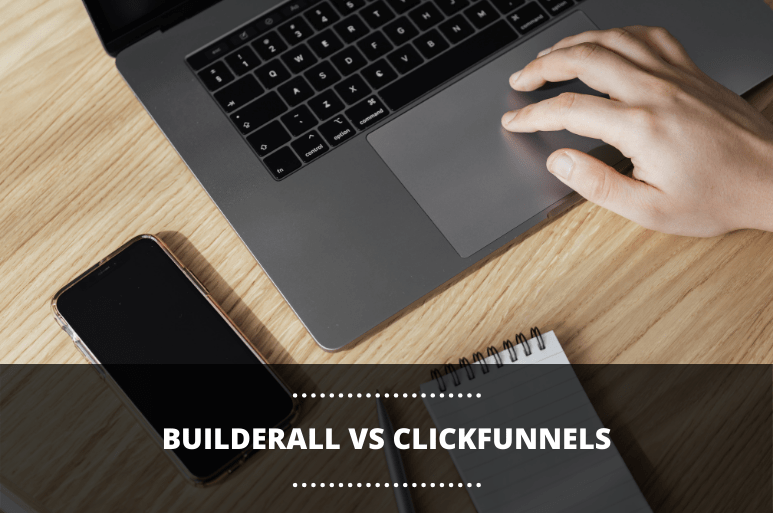If you’re reading a piece with a topic this specific, I’ll wager you already know what both ClickFunnels and Builderall are all about. We've already had an in-depth review of Clickfunnels as well as a post with 15 great alternatives for it.
So I’ll dispense with needless explanations about landing pages, sales funnels, and their various supporting services. You get it. These things are really, really, ridiculously important to your sales figures.
Now, you’re on the verge of making a very important business decision and you want an expert to help you make it.
Happy to oblige.
Here are the criteria on which I judged two of the industry’s leading marketing tools:
- Objectives and Marketing Claims
- Templates, Front-End Construction, and Customization
- Publishing
- Email Marketing
- Analytics and Performance Monitoring
- Integrations
- Other Cool Features
- Price points
Builderall vs ClickFunnels – An Overview of the Major Differences
Before we get started, it’s super important that you understand that, to an extent, we’re comparing one kind of apple to a very different kind of apple. Maybe saying that we’re comparing an apple to an apple pie is more appropriate.
While they both serve a very similar function, they’re made from slightly different components and have some key divergences in their overall objectives.
In a nutshell, Builderall aims to be a one-stop digital marketing solution and offers an exceptionally wide range of features to this end.
ClickFunnels zeroes in on a narrower objective but offers a slightly more sophisticated set of features to help you achieve it.
The Winner Revealed
I’m going to have to go with ClickFunnels. Here’s my logic. You’re not going to be comparing these two excellent tools if you’re not interested in mainly building high-converting sales funnels and landing pages.
If you were looking for two pieces of software that both offered a full-spectrum suite of digital marketing solutions, it’s very likely that Builderall would have emerged victorious.
But, I have to assume you’re reading this article because you’re considering ClickFunnels. Because your priority is to build high-converting sales funnels and landing pages.
And if this is the case, there can only be one winner.
While Builderall offers an extremely wide and extremely useful set of functions, it can’t compete with the sophistication, elegance, and single-minded efficiency of a made-for-purpose competitor.
If, however, you’re looking at this comparison from a different angle, and you’re in search of a more extensive suite of digital marketing products and services, then Builderall may be a better option.
Builderall vs ClickFunnels – the Deep Dive
Given the difference in the two tools’ objectives, the criteria for this comparison weren’t easy to come up with. In the end, I decided to (mostly) compare them where their goals overlap: the creation of sales funnels and landing pages.
I did include a section that analyzes features outside of this scope, but there was always going to be only one winner there. Given ClickFunnels’ narrower focus, there really wasn’t any way it could compete with Builderall on that front.
1. Objectives and Marketing Claims
Builderall
Builderall casts a really wide net. The creators are an ambitious group of people. They clearly have an extremely admirable goal for their product: to become a one-stop solution for pretty much every single aspect of digital marketing.
This includes the construction of sales funnels and landing pages but also involves a genuinely impressive array of other marketing automation functions.
Think of Builderall as an entire digital marketing agency, albeit one that can only respond to your configurations and is therefore dependent on your knowledge of the industry and the tool’s sometimes overwhelming set of features.
Here’s how they describe themselves on their home page:
- “Build Anything From an Amazing Website to the Most Sophisticated Sales Funnel.”
- “Try The Most Complete and Powerful Digital Marketing Platform in the World…”
- “Builderall is the only truly all-in-one high performance digital marketing platform for you to Build, Market, Sell, Amaze and Run a successful online business.”
ClickFunnels
ClickFunnels, on the other hand, have a laser-focused objective. The company is single-minded in its quest to enable its customers to create sales funnels and landing pages that are exceptional at converting visitors into customers.
Hence it offers a more limited breadth of features, but also a lot more depth and sophistication than the sales funnel functions offered by Builderall. In fact, it’s probably fair to say that no marketing tool can compete with ClickFunnels when it comes to this specialist aspect of digital marketing.
Here’s what ClickFunnels have to say about their product:
- “Quickly Create Beautiful Sales Funnels That Convert Your Visitors Into Leads And Then Customers.”
- “Yes, ClickFunnels was created so that entrepreneurs like you, who aren't programmers and who don't know how to code, can easily build beautiful pages inside of a sales funnel, to grow your company online!”
- “ClickFunnels Gives You The Tools And Strategies You Need In One Convenient Spot!”
2. Templates, Front-End Construction, and Customization
This is arguably the most important comparison criteria. How easy is it to create smart, sophisticated, effective front-ends and user-flows that result in a sky-high conversion rate? Let’s take a look at how these two tools stack up against each other.
Both Builderall and ClickFunnels take the tried-and-tested “template” approach, and both succeed at it admirably.
ClickFunnels’ offerings are a little clearer in their objective, as can be expected, but that doesn’t mean Builderall’s premade front-ends are severely inferior. ClickFunnels’ templates are highly customizable, but don’t veer outside their specific niche – sales funnels and landing pages.
So, if you’re looking for a customizable template for a more traditional website or mobile app, ClickFunnels isn’t for you.
Where ClickFunnels wins – and wins HARD – is that their templates are made-for-purpose. They follow a design framework and navigational logic that is hardwired for lead-generation and conversion success. You select the type of product you want to promote and sell, ClickFunnels does the majority of the layout work for you.
In giving their customers a wider variety of templates, Builderall falls a little short in this area. There are more to choose from, and all of them are genuinely fantastic, but ClickFunnels edges this battle because of the amount of focus they’ve put into designing their sales funnel and landing page templates.
When it comes to the front-end construction and customization user experience, there’s a lot to like about both these products. Both offer different but highly effective, industry-leading drag-and-drop page builders and customization options.
Builderall’s design UX is more varied, offering different “modes” of design, depending on what you’re building. This flexibility is seriously awesome if you want greater control and want to build front-ends that fall outside of the “sales funnel” scope.
I genuinely love both of these tools’ builders, despite their obvious differences. So much so that I can’t choose a winner for this category. Again, ClickFunnels is really fantastic if you want to build something super specific, but that doesn’t mean Builderall’s sales funnel and landing page builder lags behind in any way.
It all comes down to what your needs and preferences are. More control, or faster design turnaround times. Builderall excels at the former, while ClickFunnels serves up the latter.
3. Publishing
The ease with which you can get your landing pages live is a really big deal for most digital entrepreneurs. What’s the point in saving a bunch of time using industry-leading templates and builders if you can’t get the thing visible on appropriate platforms with a proportionate amount of effort?
Let’s look at “publishing“ as having two components. The first is the ease with which you can get your sales funnel of landing pages live. The second is the number of platforms where you can publish them.
On the former, Builderall is the clear winner. Mainly because they offer only one publishing option: their own platform. You have the option of either using a Builderall subdomain for free or purchasing a primary domain and connecting your Builderall presence to it.
As a result, the Builderall publishing process is extremely simple and ideal for users who don’t need more than one publishing platform option.
Despite being the “less complex” option in almost all of the criteria that I used when comparing these two tools, this is one area here ClickFunnels outshines Builderall in terms of sophistication.
I have to say that, despite the many publishing options ClickFunnels offers, I was genuinely disappointed to see that there wasn’t an option to simply publish my creations to their platform. It seems like such an obvious publishing option.
In the absence of a super simple publishing solution, ClickFunnels DOES offer five different and very useful alternatives. They may require a bit more effort and insight, but their application is equally effective, if not slightly more so.
You can publish your ClickFunnels sales funnels and landing pages in the following ways:
- Use your funnel pages’ ClickPop code on any of your existing websites.
- Make use of the ClickFunnels WordPress plugin.
- Embed your funnel page inside an iFrame on one of your existing, externally-hosted, websites.
- Download your ClickFunnels pages’ HTML and deploy them to any of your existing web servers.
- Easily connect your ClickFunnels pages on your Facebook page where it will display exactly as you designed it.
None of these publishing options are rocket science. And, taken as a whole, they offer a much broader and valuable spectrum of getting eyes onto your sales funnels. But they’re not ideal if all you want to do is click a couple of buttons and see your new web presence live within minutes.
Verdict: If you’re comfortable with a bit of a learning curve, ClickFunnels is the winner here. When it comes to publishing, getting your sales funnels in front of as many prospective customers as possible trumps ease of deployment. While I appreciate the simplicity of Builderall’s self-contained approach, I feel like it does compromise your reach.
4. Email Marketing Tools
Sales funnels and email marketing campaigns go hand-in-hand. A large part of why sales funnels and landing pages are such effective sales tools is because they are great at harvesting email addresses and building your pool of leads.
An integrated email marketing campaign makes it possible to nurture these leads intelligently and effectively, slowly guiding these prospective customers to the Buy Now button.
So, how do ClickFunnels and Builderall stack up against each other in the email marketing department?
Builderall
Builderall’s email automation tool is called MailingBoss and it offers everything you’ll need to build great-looking email templates, automatically categorize your subscribers, and build sophisticated, highly-personalized mail sequences based on user segmentation.
Where MailingBoss excels is in the creation of the email templates themselves. The drag-and-drop editor is capable of building extremely attractive email layouts and is also super easy to use. MailingBoss really nails this aspect of email marketing.
Unfortunately, I found Builderall’s email marketing sequence designer a little difficult to use, and I’m pretty experienced with this kind of thing. The tool’s “workflow” layout and general user experience feels needlessly complex and is likely to alienate less experienced users.
I wouldn't go so far as to say that MailingBoss’ effectiveness is hugely compromised by these shortcomings. Functionally, it offers everything you could want from an email marketing automation tool. But I will say that the learning curve is unnecessarily steep and a little frustrating.
ClickFunnels
ClickFunnels also has a bespoke email marketing tool with a clever name (Actionetics) and a bunch of really awesome features.
Leads and customers are automatically added to your various subscriber lists, getting them signed up to an email nurturing sequence that drives either conversion or an upsell. On top of this, the crucial process of lead segmentation is simple and automatic. Depending on where and how the subscriber’s address is harvested, they’re added to a customized email sequence.
In fact, Actionetics allows subscriber “tagging” which allows an incredibly granular level of segmentation – something that can be leveraged for hyper-personalized communications.
Where ClickFunnels really brings their A-game is in the creation of email sequences. It may not offer the hyper-visualized “workflow” UI that Builderall presents its users with, but this doesn’t mean it lacks in sophistication. In fact, their more traditional form-based approach is way more intuitive than MailingBoss’.
Creating email templates is extremely easy – choose from a selection of templates or create one from scratch using a simple, intuitive editor.
Verdict: ClickFunnels wins this battle by a small margin, mainly due to the unnecessary complexity of Builderall’s mail sequence builder.
5. Analytics and Performance Monitoring
Those familiar with running Sales Funnels and landing pages know that you’re never, ever done with optimization. There’s almost always a way that a particular landing page can get better at harvesting an email address or prompting a sale.
The backbone of this process is the combo of split (A/B) testing and analytics – tweaking your front-ends and gathering in-depth data on how these tweaks affect user engagement.
Both Builderall and ClickFunnels offer a generous helping of these features. Let’s see how they compare against each other.
Builderall
Setting up a split test is brutally easy in Builderall. Creating numerous different variants of a particular page using the Cheetah Website Builder section is a breeze. Setting up a variant is as simple as duplicating it and making the changes you see fit. This can be done numerous times – you’re not limited to comparing two variants of a particular page.
Once these variations have been created and served to visitors, you can view a high-level overview of the various page variants’ effectiveness at goals like, capturing email addresses, triggering a sale, navigating to a secondary page, etc.
The key term here is “high-level”. Builderall is somewhat limited in the analytics department. Split testing data on Builderall isn’t as in-depth as some super diligent salespeople may need it to be. In fact, the main report focuses squarely on one primary metric: conversion percentage (whatever you deem conversion to be).
This is super useful, undoubtedly the most important metric, but somewhat underwhelming when you consider the unbelievable depth of info other analytics tools on the market can provide.
ClickFunnels
Setting up a “duplicate” page variant from a source page is as easy as Builderall’s offering. Both tools seem to have this basic function locked down. Something different that ClickFunnels does offer here is the option to create a page variant from one of their bespoke templates. This way you’ll be testing one of your established pages against a completely new variant.
ClickFunnels also offers you the opportunity to set the traffic weighting that you want to allocate to each variant. If you feel you want a larger percentage of one particular variant served, you can configure it so.
What this does mean, is that only two page instances can be compared against each other – the control (original), and the variant. Which is fine, but I can imagine there being scenarios where a tester would want to run one split test containing more than two page variants.
As far as comparison analytics go, there’s not much between ClickFunnels and Builderall. All it offers is a slightly different view in grid format. Honestly, I would have expected these two tools to offer more granular details here. Perhaps a heat-map, bounce rates, time spent on the page, and many others.
Verdict: Builderall edges this one for me. Purely because more than two pages can be tested against each other concurrently. Sure, this comes at the expense of setting a page “exposure” weighting, but I feel like the former is more valuable than the latter.
6. Integrations
Some time ago, it would have made complete sense for an ambitious SaaS product to develop every possible service that could be of material use to the customer…
Clearly this is an objective Builderall takes slightly more seriously than ClickFunnels, but is it necessary, given the ease with which third-party tools can be integrated nowadays?
The main benefit of developing a wide set of features is that your customers don’t need to learn HOW to use integration enablement tools like Zapier. And even if the product itself offers integration protocols, these can sometimes be a little daunting to dive into for a sales-focused entrepreneur who’s running a one-person show.
Regardless, third party integration is an exceptionally valid criteria on which to judge these two apps, so let’s get to it.
Builderall
Builderall’s email marketing tool, MailingBoss, is all about integrations. Using industry-leading integration enabler, Zapier, MailingBoss can be developed into a much more extensive product than the barebones version you’ll use when you just sign up.
Click here to see everything you can do with MailingBoss using Zapier.
However, when it comes to extending Builderall’s core features, no worthwhile options exist at the time of writing this article. This is consistent with Builderall’s objective of building a self-contained suite of features.
The company is obviously aiming for a slightly less tech-savvy market who would rather become familiar with one all-encompassing tool than learn how to get more out of it with third-party integrations.
ClickFunnels
There’s no shortage of ways ClickFunnels can be extended with the integration of external apps and services. Zapier’s website has a dedicated page listing all the ways this can be done.
All the usual suspects are there. From the big-hitters like Slack, SalesForce, Shopify, Stripe, and HubSpot, to lesser known, but no less useful tools like Burst SMS, Podio, Klick-Tipp, and Flodesk.
Verdict: At the time of writing this article, it’s possible to connect ClickFunnels with over TWO THOUSAND apps. So yeah… this isn’t much of a competition. ClickFunnels takes it home.
7. Other Cool Features
Here we’re going to look at other features that we didn’t get to cover in our comparison so far. Features that range from “neat!” to “I don’t know how I could do business without this.”
These functions aren’t necessarily dealbreakers, and their sum is arguably more valuable than than their individual worth.
We want to take a look at the little value-adds that seem like nice-to-haves individually, but, as a whole, come together to add significant weight to a product’s overall value.
Builderall Features
- The site/page builder includes a mobile app builder
- Integrated CRM system
- Chatbot
- Webinar streaming platform
- Facebook Messenger Chatbox
- SMS & WhatsApp messaging
- Technical support ticketing system
- Sophisticated image creator and editor
ClickFunnels Features
- Affiliate program, with tracking and management
- Email auto responders
- Rudimentary, but more-than-adequate CRM system
- Fully prebuilt funnel templates
- Detailed email performance tracking and analytics
- Business KPI target monitoring dashboard
Verdict: Undefined. Again, it really comes down to what your needs are. If you’re looking for a tool that offers a broad range of features that extend beyond building incredibly effective sales funnels and landing pages, Builderall wins this comfortably.
However, if you’re looking for a built-for-purpose sales funnel tool offering the best functionality for a specific purpose, ClickFunnels is undoubtedly the way to go.
8. Pricing
What do you get for your monthly (or yearly) subscription? Is it worth the cost? How much core functionality is available on each of these tools’ free tiers, and how many of these features are only available to those willing to splash out on the most expensive subscription tiers?
Let’s take a really deep look at this, since it’s probably one of the biggest decision drivers for most businesses trying to keep their financial commitments to a reasonable figure.
Builderall Pricing
Builderall has a pretty innovative approach to the multi-tiered subscription plan approach. The more affordable of the two plans, the Premium Plan will set you back $69.90 per month. The more extensive Funnel Club Plan has the exact same monthly subscription payment, but includes a one-off fee of $199.00.
Here’s a summary of the two plans as well as the primary differences between them.
- Both plans allow you to create 15 domans, use 10GB of disk space, and sign up an unlimited number of subscribers.
- Both plans give users access to all software features.
- The main difference between the two plans comes down to accessing premade funnels. For instance, the Funnel Club gives subscribers access to:
- More than 50 niche digital marketing platform funnels
- More than 50 niche funnels for agencies
- More than 10 Builderall “Premium Funnels”
- Access to ten new niche funnels every week.
In a sense, Builderall only has one price point, with every single one of the tool’s features available on it. By paying a one-off fee of $199.00, the customer gets access to a very generous selection of premade funnel templates.
The Funnel Club plan is obviously aimed at customers who intend to deploy a large number of funnels like digital marketing agencies.
This is a very unique way of pricing their plans. On the one hand, you’re getting an absolute gem of a tool, with no feature limitations, on the most affordable pricing tier. On the other hand, you have to depart with a relatively steep amount of cash to have access to any premade templates.
Whether this works or not is going to be super subjective. Do you need access to professionally designed funnels, or are you confident in your funnel-design skills? Because you'll clearly need them if you’re opting for Builderall’s Premium Plan.
ClickFunnels Pricing
As with Builderall, ClickFunnels also believe that there’s no point in hiding certain functions behind pricing tiers. Regardless of which plan you select, you’ll have access to every single feature the tool has to offer.
As you move up the pricing ladder additional “consumption” resources and additional educational materials become available. This ties ClickFunnels’ cost almost entirely to your output rather than what you want to do with it.
ClickFunnels is quite a bit more costly than Builderall, with the basic ClickFunnels Plan coming in at $97.00 per month. This plan allows you to build 20 funnels and 100 pages. It also limits you to one user, three payment gateways, and three domains.
At $297.00 per month, ClickFunnels Platinum is significantly more expensive. It allows you to create unlimited funnels and pages, while allowing you three different user logins. It also gives you access to nine payment gateways and nine domains, amongst other support and training benefits.
ClickFunnels TwoCommaClub will set you back a whopping $2,497 per month. It also offers unlimited funnels and pages but allows you 10 unique logins, 27 payment gateways, and 27 domains. Additional support and educational resourcebus also become available to you on this subscription plan.
Clickfunnels DOES have a 14-day free trial that you can sign up for here.
Verdict: This one isn’t really possible to call, given how neither product has a free option, their most affordable options are genuinely quite affordable, and both offer full feature access regardless of the plan you choose.




